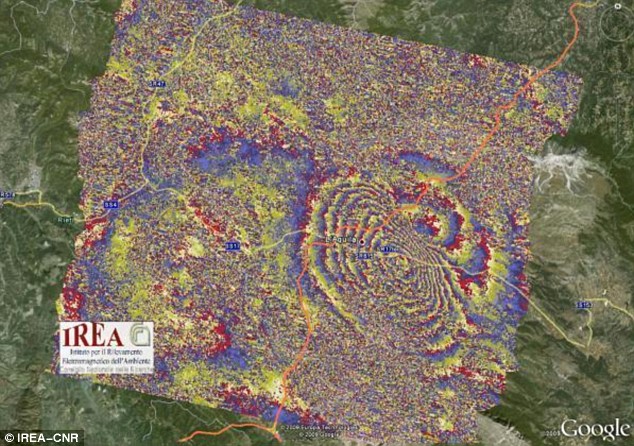
Its rainbow-coloured interference patterns were deduced using 'synthetic aperture radar' (SAR) data from the European Space Agency's (ESA) Envisat and the Italian Space Agency's COSMO-SkyMed satellites.
Earthquake
Scientists from Italy's National Institute of Geophysics and Volcanology (INGV) and the Istituto per il Rilevamento Elettromagnetico dell' Ambiente (IREA-CNR) are mapping the surface deformations during the earthquake and its the numerous aftershocks using a technique known as SAR Interferometry (InSAR), a sophisticated version of 'spot the difference'.
The Envisat interferogram shows nine fringes surrounding the epicentre, located midway between L'Aquila and Fossa, where the ground moved up to an incredible 25cm, explains Stefano Salvi from INGV's Earthquake Remote Sensing Group.
The giant quake, which measured 6.2 on the Richter scale, struck the city of L'Aquila in central Italy and the surrounding area on 6 April last week.
The tragedy has claimed hundreds of lives and left thousands homeless.
Another Italian scientist predicted the seismic activity weeks before it struck but was reported to authorities for spreading panic.
L'Aquila
The InSAR technique involves combining two or more radar images of the same ground location taken at different points so that very precise measurements - down to the scale of a few millimetres - can be made of any ground motion taking place between them.
In this case, it merged data acquired before and after the earthquake to generate 'interferogram' images that appear as rainbow-coloured interference patterns.
A complete set of coloured bands, called 'fringes', represents ground movement relative to the spacecraft of half a wavelength, which is 2.8cm in the case of Envisat's data.
The first Envisat data, acquired after the earthquake on 12 April, were made immediately available to the scientists.
Riccardo Lanari of IREA-CNR in Naples, said: 'We produced an interferogram just a few hours after the Envisat acquisition by combining these data with data acquired before the earthquake on 1 February.
Giacchino Giuliani
'We were pleased that we were able to immediately see the pattern of the earthquake.'
Salvi said the team was able to confirm preliminary results obtained with Envisat data by comparison with 3D ground displacements calculated from five different GPS location sites.
The COSMO-SkyMed constellation, which is currently made up of three satellites, allows for frequent data. This means new interferograms can be calculated every few days.
Ground deformation around the L'Aquila area over the next months will be densely sampled using COSMO-SkyMed and Envisat data and possibly SAR data from other satellites.
It could make this earthquake one of the most ever covered by InSAR measurements.
The ESA is making its Earth observation dataset collected over the L'Aquila area freely accessible to encourage other scientists to join in the analysis. The dataset will be continuously updated with the newest Envisat acquisitions.



Reader Comments
to our Newsletter